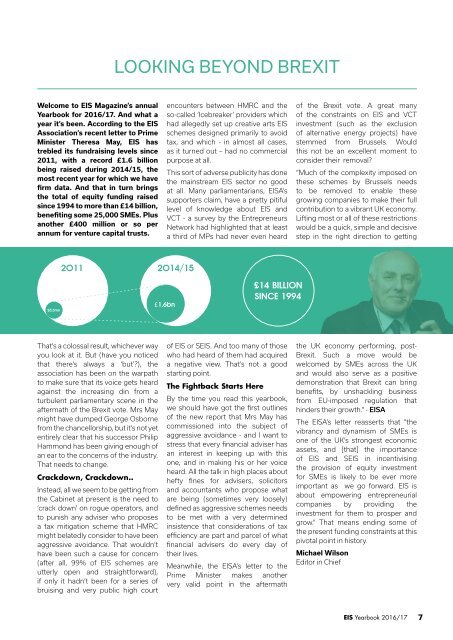2fnoNyY
2fnoNyY
2fnoNyY
You also want an ePaper? Increase the reach of your titles
YUMPU automatically turns print PDFs into web optimized ePapers that Google loves.
LOOKING BEYOND BREXIT<br />
Welcome to EIS Magazine’s annual<br />
Yearbook for 2016/17. And what a<br />
year it’s been. According to the EIS<br />
Association’s recent letter to Prime<br />
Minister Theresa May, EIS has<br />
trebled its fundraising levels since<br />
2011, with a record £1.6 billion<br />
being raised during 2014/15, the<br />
most recent year for which we have<br />
firm data. And that in turn brings<br />
the total of equity funding raised<br />
since 1994 to more than £14 billion,<br />
benefiting some 25,000 SMEs. Plus<br />
another £400 million or so per<br />
annum for venture capital trusts.<br />
encounters between HMRC and the<br />
so-called ‘Icebreaker’ providers which<br />
had allegedly set up creative arts EIS<br />
schemes designed primarily to avoid<br />
tax, and which - in almost all cases,<br />
as it turned out – had no commercial<br />
purpose at all.<br />
This sort of adverse publicity has done<br />
the mainstream EIS sector no good<br />
at all. Many parliamentarians, EISA’s<br />
supporters claim, have a pretty pitiful<br />
level of knowledge about EIS and<br />
VCT - a survey by the Entrepreneurs<br />
Network had highlighted that at least<br />
a third of MPs had never even heard<br />
of the Brexit vote. A great many<br />
of the constraints on EIS and VCT<br />
investment (such as the exclusion<br />
of alternative energy projects) have<br />
stemmed from Brussels. Would<br />
this not be an excellent moment to<br />
consider their removal?<br />
“Much of the complexity imposed on<br />
these schemes by Brussels needs<br />
to be removed to enable these<br />
growing companies to make their full<br />
contribution to a vibrant UK economy.<br />
Lifting most or all of these restrictions<br />
would be a quick, simple and decisive<br />
step in the right direction to getting<br />
£5.3mn<br />
2011 2014/15<br />
£1.6bn<br />
£14 BILLION<br />
SINCE 1994<br />
That’s a colossal result, whichever way<br />
you look at it. But (have you noticed<br />
that there’s always a ‘but’?), the<br />
association has been on the warpath<br />
to make sure that its voice gets heard<br />
against the increasing din from a<br />
turbulent parliamentary scene in the<br />
aftermath of the Brexit vote. Mrs May<br />
might have dumped George Osborne<br />
from the chancellorship, but it’s not yet<br />
entirely clear that his successor Philip<br />
Hammond has been giving enough of<br />
an ear to the concerns of the industry.<br />
That needs to change.<br />
Crackdown, Crackdown..<br />
Instead, all we seem to be getting from<br />
the Cabinet at present is the need to<br />
‘crack down’ on rogue operators, and<br />
to punish any adviser who proposes<br />
a tax mitigation scheme that HMRC<br />
might belatedly consider to have been<br />
aggressive avoidance. That wouldn’t<br />
have been such a cause for concern<br />
(after all, 99% of EIS schemes are<br />
utterly open and straightforward),<br />
if only it hadn’t been for a series of<br />
bruising and very public high court<br />
of EIS or SEIS. And too many of those<br />
who had heard of them had acquired<br />
a negative view. That’s not a good<br />
starting point.<br />
The Fightback Starts Here<br />
By the time you read this yearbook,<br />
we should have got the first outlines<br />
of the new report that Mrs May has<br />
commissioned into the subject of<br />
aggressive avoidance - and I want to<br />
stress that every financial adviser has<br />
an interest in keeping up with this<br />
one, and in making his or her voice<br />
heard. All the talk in high places about<br />
hefty fines for advisers, solicitors<br />
and accountants who propose what<br />
are being (sometimes very loosely)<br />
defined as aggressive schemes needs<br />
to be met with a very determined<br />
insistence that considerations of tax<br />
efficiency are part and parcel of what<br />
financial advisers do every day of<br />
their lives.<br />
Meanwhile, the EISA’s letter to the<br />
Prime Minister makes another<br />
very valid point in the aftermath<br />
the UK economy performing, post-<br />
Brexit. Such a move would be<br />
welcomed by SMEs across the UK<br />
and would also serve as a positive<br />
demonstration that Brexit can bring<br />
benefits, by unshackling business<br />
from EU-imposed regulation that<br />
hinders their growth.” - EISA<br />
The EISA’s letter reasserts that “the<br />
vibrancy and dynamism of SMEs is<br />
one of the UK’s strongest economic<br />
assets, and [that] the importance<br />
of EIS and SEIS in incentivising<br />
the provision of equity investment<br />
for SMEs is likely to be ever more<br />
important as we go forward. EIS is<br />
about empowering entrepreneurial<br />
companies by providing the<br />
investment for them to prosper and<br />
grow.” That means ending some of<br />
the present funding constraints at this<br />
pivotal point in history.<br />
Michael Wilson<br />
Editor in Chief<br />
EIS Yearbook 2016/17<br />
7


